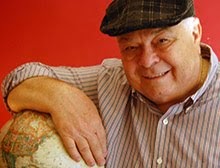 |
| Red tiled roofs of the Alhambra in Spain (wikipedia) |
GRANADA, SPAIN – For nearly 250 years the Alhambra palace in Granada, Andalusia, Spain, known affectionately as "The Red Fortress", served as the palace, harem, residence of court officials and, at one time, a garrison of 40,000 soldiers. Even so, though massive in scale, its relatively unassuming exterior opens into an ultra-decorated interior filled with ornate designs and geometric patterns that virtually cover every inch of its walls, ceilings, courtyards and cloisters.
 |
| Generalife exterior (wikipedia) |
Begun in the 9th century by the Islamic Caliphate,
most of what visitors see today is the result of two reigns between 1333 and
1391. Yusuf I and Muhammad V provided most of the inspiration in what is
regarded as the greatest expression of Spanish Muslim art and architecture in
the world.
As an inscription on one wall in the Alhambra says, "Nothing in life could be more cruel
than to be blind in Granada
 |
| Fountains abound at the Alhambra (wikipedia) |
But there is more to the history of the Alhambra Alhambra in the same year that
Christopher Columbus obtained his commission to seek a new route to India
The king and queen stayed busy during that year,
spending much of their time partially restoring the various palaces to
Renaissance preferences.
 |
| Spanish Inquisition by Goya (wikipedia) |
Among the most enchanting aspects of the Alhambra
Also present are the delightful warbling sounds of
nightingales that enhance the sounds of the cascading water.
Ferdinand and Isabella were also responsible for
establishing the Spanish Inquisition in 1478 in an effort to maintain Catholic
orthodoxy in their kingdoms. Though not officially abolished until 1834, the
Inquisition only had jurisdiction over baptized Christians. There was a
loophole, however. Freedom of religion was non-existent during much of the
period in which the Inquisition thrived which, therefore related to all royal
subjects.
 |
| Intricate Arabic carvings can be found everywhere at the Alhambra (wikipedia) |
Construction on the fortress began in 889 CE on
the site of a small Roman fortification. For several hundred years the Alhambra
Today, the Alhambra
 |
| Gardens aplenty adorn the grounds (wikipedia) |
Oddly enough there are also caves encircling the Alhambra
Visitors today do not enter through the Gate of
Justice, the original access. Due to overwhelming attendance, the primary entrance
could not accommodate modern-day throngs.
 |
| Arcaded gardens at the Generalife in Granada (wikipedia) |
The Alhambra
 |
| Ceiling of the Two Sisters Hall (wikipedia) |
Among the most popular sites is the Court of the
Lions, a rectangular courtyard that is roughly 116 feet long and 66 feet wide.
It is surrounded by 124 white marble columns supporting a low gallery with a
pavilion penetrating into the court at either end. The delicate and ornate
walls extend to a domed roof while the walls are covered with blue and yellow
tiles, with an enameled blue and gold border.
Directly in the center of the courtyard is the Fountain of Lions. Twelve sculptured white marble lions support an alabaster basin that gurgles with the sound of water gently lapping the pool. The lions are not created with anatomic accuracy but are instead designed to symbolize strength.
 |
| Court of the Lions (wikipedia) |
Directly in the center of the courtyard is the Fountain of Lions. Twelve sculptured white marble lions support an alabaster basin that gurgles with the sound of water gently lapping the pool. The lions are not created with anatomic accuracy but are instead designed to symbolize strength.
Often travelers in a hurry fail to experience the
Palacio de Generalife or the "Garden of the Architect."
The Generalife has been restored several times
since its creation in the 14th century. Situated on the summit of Monte Mauror
is the Martyrs' Villa commemorating the Christian slaves who were forced to
build the Alhambra
Also situated on Monte Mauror are the Vermilion Towers
 |
| Gardens and fountains are a hallmark of the Alhambra (wikipedia) |
The Alhambra is
well worth a visit, and proof positive that under Ferdinand and Isabella, at
least, "the reign in Spain








































